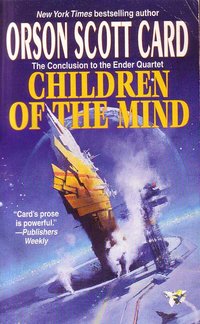Children of the Mind
|
|
Children of the Mind is the fourth book of Orson Scott Card's popular science fiction series begun with Ender's Game, on the path that focuses on Ender himself. Despite tying up the loose ends from Speaker for the Dead and Xenocide, and exploring various related philosophical avenues, it was criticized by both critics and fans for being too much of a departure from what was expected of the Ender sequence.
Backstory
Andrew Wiggin, a military genius chosen in Ender's Game to defend Earth against the alien race of Formics ("buggers"), later to become a speaker for the dead in the novel of the same title, traveled to the colony planet Lusitania in that novel, befriended a family of scientists under considerable psychological trauma, and fell in love with the widowed mother. He has also chosen this planet as the planet to allow his hive queen cocoon, the last surviving member of the bugger race he annihilated in Ender's Game, to hatch. Ender's family befriended the pequeninos, a second sentient alien race and, contrary to orders from Starways Congress, begin teaching them human technology.
Crucial to the pequeninos' life cycle is the descolada virus, which infects alien species and kills everything it cannot mutate to its own needs. After the pequeninos kill a colonist and Starways Congress discovers that the humans have been teaching the pequeninos human technology, Starways Congress orders two of the colonists to a distant world to stand trial. As the length of the trip would mean the two accused would never see their family alive again, regardless of what sentence was passed, the colonists balk and refuse to send them. On discovering this insurrection, and also discovering the descolada's continued fight to subvert the methods used to contain it, Starways Congress orders the planet destroyed.
In Xenocide, Jane, a third, disembodied alien life form who lives in the ansible networks which allow instantaneous interplanetary communication, discovers that while transporting Ender in a spacecraft she can move the spacecraft completely outside the known universe and back in to a different point anywhere at all, also instantaneously. But Congress has already sent the Lusitania fleet to destroy the planet, even though it's known to hold a sentient alien species; and any attempt she makes to block their arrival will be discovered. Nonetheless she attempts to slow their arrival; Congress discovers the interference and begins to shut down the ansible network, thinking of her as a virus which must be purged.
Jane realizes that she was Outside the universe before being called into being inside, and that by travelling and remaining outside for awhile, a being can call into existence new beings according to what they desire to exist. Jane has drifted apart from Ender as a result of Ender's shutting off a communication one day, brusquely and without thought, and become close to Miro, the physically disabled and brain-damaged son of Ender's wife, Novinha. Miro was crippled in an attempt to help the pequeninos near the end of Speaker for the Dead.
Ela, one of Novinha's daughters, is a scientist trying to discover a cure for the descolada virus. Jane and Novinha's family decide that Ela must travel Outside the universe to try to create the cure for the descolada; because Jane is now as close to Miro as to Ender; both Miro and Ender travel with her. While outside the universe, Miro imagines himself in his body as it was before he was crippled; he jumps to a new body and his old one dissoves into dust; and Ender unwittingly calls into being manifestations of his altruistic sister Valentine and his cruel but politically-minded brother Peter. Ela successfully creates a virus which causes the effects the pequeninos need in their life cycle without attempting to kill everything it can't convert.
Children of the Mind
At the start of Children of the Mind, Jane is taking Formics, humans, and pequeninos to distant habitable planets to colonize them, but is losing her memories and concentration as a result of the vast ansible and computer network being shut down. If she is to live, she must find a way to transfer herself to a different body. Ender's wife has left him to join a religious order; Ender now controls his own body as well as young Valentine's and Peter's, but his own body is suffering as a result of his split attention. Peter is off to distant worlds to try to convince people diplomatically that destroying the planet would constitute a second xenocide, and Valentine and Miro are spending all available time looking for additional habitable planets. The Lusitania fleet is expected to arrive outside the planet and destroy it within a few weeks. In the end, Ender leaves his body and previous life behind to live as Peter, and Jane is granted possession of Val's body; she falls in love with Miro, and Peter with Wang-mu; and Peter's efforts come to fruition, and the fleet is averted.

